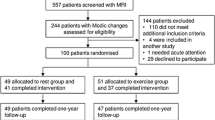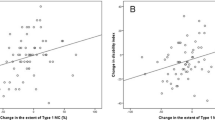Abstract
Purpose
Modic changes (MCs) have been suggested to be a diagnostic subgroup of low back pain (LBP). However, the clinical implications of MCs remain unclear. For this reason, the aims of this study were to investigate how MCs developed over a 14-month period and if changes in the size and/or the pathological type of MCs were associated with changes in clinical symptoms in a cohort of patients with persistent LBP and MCs.
Methods
Information on LBP intensity and detailed information from MRI on the presence, type and size of MCs was collected at baseline and follow-up. Changes in type (Type I, II, III and mixed types) and size of MCs were quantified at both time points according to a standardised evaluation protocol. The associations between change in type, change in size and change in LBP intensity were calculated using odds ratios (ORs).
Results
Approximately 40 % of the MCs followed the expected developmental path from Type I (here Type I or I/II) to Type II (here Type II or II/III) or Type I to Type I/II. In general, the bigger the size of the MC at baseline, the more likely it was that it remained unchanged in size after 14 months. Patients who had MC Type I at both baseline and 14-month follow-up were less likely to experience an improvement in their LBP intensity as compared to patients who did not have Type I changes at both time points (OR 7.2, CI 1.3–37). There was no association between change in size of MCs Type I and change in LBP intensity.
Conclusions
The presence of MCs Type I at both baseline and follow-up is associated with a poor outcome in patients with persistent LBP and MCs.



Similar content being viewed by others
References
Albert HB, Manniche C (2007) Modic changes following lumbar disc herniation. Eur Spine J 16:977–982
Arana E, Kovacs FM, Royuela A, Estremera A, Asenjo B, Sarasibar H et al (2011) Modic changes and associated features in Southern European chronic low back pain patients. Spine J 11:402–411
Braithwaite I, White J, Saifuddin A, Renton P, Taylor BA (1998) Vertebral end-plate (Modic) changes on lumbar spine MRI: correlation with pain reproduction at lumbar discography. Eur Spine J 7:363–368
Bram J, Zanetti M, Min K, Hodler J (1998) MR abnormalities of the intervertebral disks and adjacent bone marrow as predictors of segmental instability of the lumbar spine. Acta Radiol 39:18–23
Brooks R (1996) EuroQol: the current state of play. Health Policy 37:53–72
Childs JD, Piva SR, Fritz JM (2005) Responsiveness of the numeric pain rating scale in patients with low back pain. Spine (Phila Pa 1976) 30:1331–1334
Chung CB, Vande Berg BC, Tavernier T, Cotten A, Laredo JD, Vallee C et al (2004) End plate marrow changes in the asymptomatic lumbosacral spine: frequency, distribution and correlation with age and degenerative changes. Skeletal Radiol 33:399–404
de Roos A, Kressel H, Spritzer C, Dalinka M (1987) MR imaging of marrow changes adjacent to end plates in degenerative lumbar disk disease. AJR Am J Roentgenol 149:531–534
Jensen TS, Bendix T, Sorensen JS, Manniche C, Korsholm L, Kjaer P (2009) Characteristics and natural course of vertebral endplate signal (Modic) changes in the Danish general population. BMC Musculoskelet Disord 10:81
Jensen TS, Karppinen J, Sorensen JS, Niinimaki J, Leboeuf-Yde C (2008) Vertebral endplate signal changes (Modic change): a systematic literature review of prevalence and association with non-specific low back pain. Eur Spine J 17:1407–1422
Jensen RK, Leboeuf-Yde C, Wedderkopp N, Sorensen JS, Manniche C (2012) Rest versus exercise as treatment for patients with low back pain and Modic changes. A randomised controlled clinical trial. BMC Med 10(1):22
Jensen TS, Sorensen JS, Kjaer P (2007) Intra- and interobserver reproducibility of vertebral endplate signal (modic) changes in the lumbar spine: the Nordic Modic Consensus Group classification. Acta Radiol 48:748–754
Karchevsky M, Schweitzer ME, Carrino JA, Zoga A, Montgomery D, Parker L (2005) Reactive endplate marrow changes: a systematic morphologic and epidemiologic evaluation. Skeletal Radiol 34:125–129
Kjaer P, Korsholm L, Bendix T, Sorensen JS, Leboeuf-Yde C (2006) Modic changes and their associations with clinical findings. Eur Spine J 15:1312–1319
Kjaer P, Leboeuf-Yde C, Korsholm L, Sorensen JS, Bendix T (2005) Magnetic resonance imaging and low back pain in adults: a diagnostic imaging study of 40-year-old men and women. Spine (Phila Pa 1976) 30:1173–1180
Kleinstuck F, Dvorak J, Mannion AF (2006) Are “structural abnormalities” on magnetic resonance imaging a contraindication to the successful conservative treatment of chronic nonspecific low back pain? Spine 31:2250–2257
Kuisma M, Karppinen J, Haapea M, Lammentausta E, Niinimaki J, Tervonen O (2009) Modic changes in vertebral endplates: a comparison of MR imaging and multislice CT. Skeletal Radiol 38:141–147
Kuisma M, Karppinen J, Niinimaki J, Kurunlahti M, Haapea M, Vanharanta H et al (2006) A three-year follow-up of lumbar spine endplate (Modic) changes. Spine (Phila Pa 1976) 31:1714–1718
Kuisma M, Karppinen J, Niinimaki J, Ojala R, Haapea M, Heliovaara M (2007) Modic changes in endplates of lumbar vertebral bodies: prevalence and association with low back and sciatic pain among middle-aged male workers. Spine (Phila Pa 1976) 32:1116–1122
Lei D, Rege A, Koti M, Smith FW, Wardlaw D (2008) Painful disc lesion: can modern biplanar magnetic resonance imaging replace discography? J Spinal Disord Tech 21:430–435
Lim CH, Jee WH, Son BC, Kim DH, Ha KY, Park CK (2005) Discogenic lumbar pain: association with MR imaging and CT discography. Eur J Radiol 54:431–437
Luoma K, Vehmas T, Gronblad M, Kerttula L, Kaapa E (2008) MRI follow-up of subchondral signal abnormalities in a selected group of chronic low back pain patients. Eur Spine J 17:1300–1308
Mitra D, Cassar-Pullicino VN, McCall IW (2004) Longitudinal study of vertebral type-1 end-plate changes on MR of the lumbar spine. Eur Radiol 14:1574–1581
Modic MT, Masaryk TJ, Ross JS, Carter JR (1988) Imaging of degenerative disk disease. Radiology 168:177–186
Modic MT, Ross JS (2007) Lumbar degenerative disk disease. Radiology 245:43–61
Modic MT, Steinberg PM, Ross JS, Masaryk TJ, Carter JR (1988) Degenerative disk disease: assessment of changes in vertebral body marrow with MR imaging. Radiology 166:193–199
O’Neill C, Kurgansky M, Kaiser J, Lau W (2008) Accuracy of MRI for diagnosis of discogenic pain. Pain Physician 11:311–326
Ohtori S, Inoue G, Ito T, Koshi T, Ozawa T, Doya H et al (2006) Tumor necrosis factor-immunoreactive cells and PGP 9.5-immunoreactive nerve fibers in vertebral endplates of patients with discogenic low back Pain and Modic Type 1 or Type 2 changes on MRI. Spine (Phila Pa 1976) 31:1026–1031
Patrick DL, Deyo RA, Atlas SJ, Singer DE, Chapin A, Keller RB (1995) Assessing health-related quality of life in patients with sciatica. Spine (Phila Pa 1976) 20:1899–1908
Rabin R, de CF (2001) EQ-5D: a measure of health status from the EuroQol Group. Ann Med 33:337–343
The EuroQol Group (1990) EuroQol—a new facility for the measurement of health-related quality of life. Health Policy 16:199–208
Thompson KJ, Dagher AP, Eckel TS, Clark M, Reinig JW (2009) Modic changes on MR images as studied with provocative diskography: clinical relevance–a retrospective study of 2457 disks. Radiology 250:849–855
Williamson A, Hoggart B (2005) Pain: a review of three commonly used pain rating scales. J Clin Nurs 14:798–804
Acknowledgments
Supported by grants from the Danish Foundation of Chiropractic Research and Postgraduate Education and from the VELUX Foundation.
Conflict of interest
None.
Author information
Authors and Affiliations
Corresponding author
Rights and permissions
About this article
Cite this article
Jensen, R.K., Leboeuf-Yde, C., Wedderkopp, N. et al. Is the development of Modic changes associated with clinical symptoms? A 14-month cohort study with MRI. Eur Spine J 21, 2271–2279 (2012). https://doi.org/10.1007/s00586-012-2309-9
Received:
Revised:
Accepted:
Published:
Issue Date:
DOI: https://doi.org/10.1007/s00586-012-2309-9




